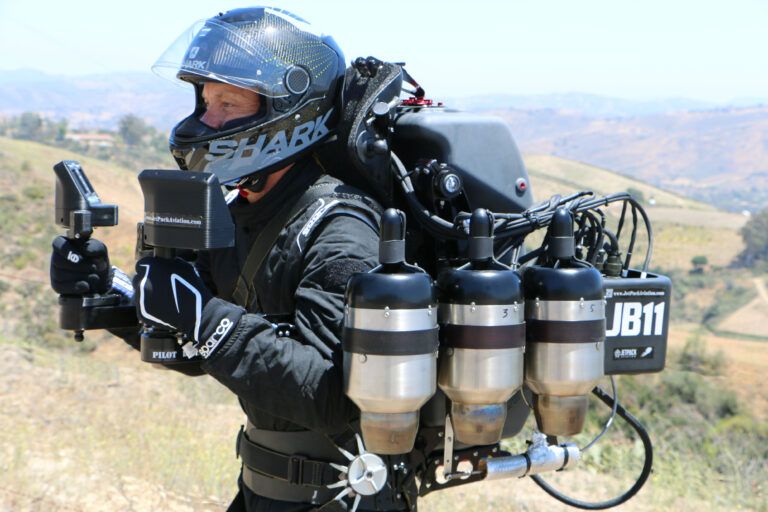JetPack Aviation develops and sells foot-launched aircraft. Its latest project is the Speeder, a futuristic air vehicle that resembles a jet ski for the air and is aimed initially at the defense sector. The Speeder’s development program, like the company’s CEO and founder David Mayman is unabashedly ambitious.
The first prototype backpack mounted jetpack made by the company flew about ten years ago. Mayman himself then piloted it around the Statue of Liberty in 2015, garnering global media attention.
Aerospace Testing International talked to Mayman about what the company has achieved with the jetpack and the development of the new Speeder aircraft.
Why fly around the Statue of Liberty?
We wanted to send a message to the world that we had built the jetpack and that we could make flights happen within all the rules and regulations.
After that flight in 2016 we won a collaboration contract with the US Navy SEALs. But we found during the trials that training the operators took too long and that the payload and the range was too limited for their applications. The US Navy asked for an aircraft that could lift 300 lbs (130kg) and fly for more than half an hour at 230mph (370km/h).
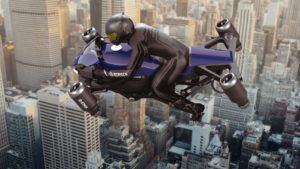 Using current technology that can’t be a jetpack, so the concept of the Speeder was born. The Speeder is still small, about the size of a motorcycle and can carry up to 600 lbs (270kg) and fly a lot longer. It can also be flown autonomously, so the training is minimal.
Using current technology that can’t be a jetpack, so the concept of the Speeder was born. The Speeder is still small, about the size of a motorcycle and can carry up to 600 lbs (270kg) and fly a lot longer. It can also be flown autonomously, so the training is minimal.
Is the JetPack being used?
We have refined the first JB10 jetpack and moved on to the JB11 and JB12, which have six engines instead of two. They feature redundancy in case an engine fails. We operate those at events and in movies and TV commercials and we run training in Southern California. We also sell them to governments, including recently in South East Asia.
How mature is the JetPack platform?
It’s not as good as its going to get. The engine design will continue to develop to improve the fuel consumption and the thrust to weight ratio. The software flight control system that we wrote monitors thrust, stability, speed, height and all elements of flight control.
What applications are there for the JetPack?
It’s any case where you need to pull an aircraft out of a suitcase. You can’t take a helicopter everywhere with you. It will take you up to 10 miles (16km) at over 100mph (160km/h). So with the Navy Special Forces we practiced ship-to-ship operations. A jetpack is preferable over clambering up the hull of a hostile ship at night. You can also get medics into place much faster without risking a helicopter and its crew with a jetpack and be first responder to the start of wildfires in an automated format. The military applications are endless.
What is it like flying a JetPack?
Incredible. It never gets old. Every time I get to fly a jetpack it’s an extraordinary sensation. It’s small and light and can catapult you into the air at a rate of more than 2000ft/min, rapidly accelerate to 100mph and turn on a dime. It’s like riding a motorcycle or push bike in the air – it’s that maneuverable.
Why do you describe the Speeder as a motorcycle for the air?
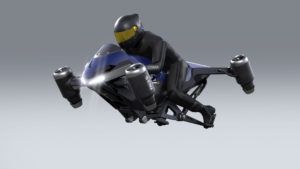 It doesn’t have wheels, but it is a similar form factor to a motorcycle or jet ski. The idea is that it is small enough to put in a trailer and can be launched from anywhere. That is what differentiates it from helicopters, eVTOLs or drones. They are ten times the footprint if you want to lift the same payload, but can only manage a third of the speed. It also doesn’t need an extensive aviation infrastructure to support operations, it can literally take off from and land in a car park size space.
It doesn’t have wheels, but it is a similar form factor to a motorcycle or jet ski. The idea is that it is small enough to put in a trailer and can be launched from anywhere. That is what differentiates it from helicopters, eVTOLs or drones. They are ten times the footprint if you want to lift the same payload, but can only manage a third of the speed. It also doesn’t need an extensive aviation infrastructure to support operations, it can literally take off from and land in a car park size space.
How much common technology is there between the JetPack and Speeder?
The design for the Speeder was a blank canvas. The engine computers and the way that we balance the thrust across the engines are very similar. We takeoff vertically but want to be flying horizontally in a short time. We had to learn about gimbaling the engines and develop jetevators to direct the thrust in two axes. If you look at the range of control inputs, it’s extraordinary. The engines can be moved forward and aft and the same with the jetevators. Then there is some degree of differential thrust – turbine engines don’t spool up and down like electric motors on a drone – so there is some lag.
There are four engines on the prototype and for the production version we are planning on up to eight. They will produce roughly 1000 newtons per engine, but it depends on the engine we select. There is lot more development work to be done and we will probably end up using turbine fans rather than turbo jets.
In terms of payload we are looking at 600 lbs with full fuel and 25-30 minutes flight time, with an hour in forward flight thanks to the aerodynamic lift that is created by the body and winglets.
At what point is work on the Speeder?
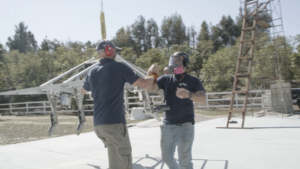 Development started after we got funding from the Y Combinator accelerator program and some wonderful VCs in Silicon Valley during 2019. We did our physics modeling and flight systems development on computer during 2019 and half way through 2020. We then started building the aircraft and were flight testing at the end of 2020. We finished the initial flight test program for the full-scale prototype, the P1 during May this year.
Development started after we got funding from the Y Combinator accelerator program and some wonderful VCs in Silicon Valley during 2019. We did our physics modeling and flight systems development on computer during 2019 and half way through 2020. We then started building the aircraft and were flight testing at the end of 2020. We finished the initial flight test program for the full-scale prototype, the P1 during May this year.
We started testing at a US Navy facility near Los Angeles on longitudinal and lateral tether lines. We then removed the lateral line to allow it to roll. We eventually took away the longitudinal line so there was just one tether on top.
The tether line makes it more difficult to test but is there because the prototype is our only test asset and we have invested pretty much all our money in it. Once the Speeder gets to a certain height the tether line goes completely slack.
What are the next steps for the Speeder’s testing program?
At our MoorPark facility in California we can only do forward transitions for 90ft (27m). It’s great for hover testing but for transition testing we need to find another site. We plan to start testing the next iteration of the prototype, the P1.5 during late summer or early fall
this year.
P1.5 will not have the outer aluminum frame that P1 has to attach the tether lines. P1.5 will look much more like an aircraft. P1.5 will go back through hover tests to ensure the jetevator and gimbal system work just as well as they did on the P1. Then we will enable differential GPS to give us better position holding. We’ll then venture off the tether with forward transitions.
When will the Speeder be piloted?
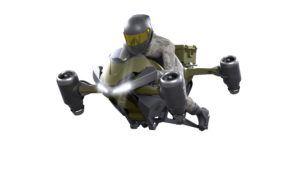 It’s not been flown with a human on board yet. I am putting my hand up to be the first and almost everyone says no, not yet!
It’s not been flown with a human on board yet. I am putting my hand up to be the first and almost everyone says no, not yet!
Is there any similar projects?
When we started there were just five eVTOL developers in the world and now there are over 300. But I don’t know anyone who has a turbojet or turbofan version like this. It’s basically a small version of a F-35.
What is particularly challenging about the Speeder project?
We had to write all the code from scratch because it doesn’t exist for turbine VTOL. The Harrier is about the closest you get. Writing that code, running it through MatLab and SimuLink and then in the vehicle iteratively was a fascinating process. It was great when P1 performed very closely in the test environment to
the simulations.
The biggest challenge has been to create control systems that can react fast enough to hold position. It’s relatively easy to create control systems that perform a slow forward transition. But holding position is a real challenge and the jetevator’s job.
The jetevators were first modeled on the computer, the size, shape and mounting position, the rate of movement and understanding the torque values for the actuators. Then we ran them on a testbed, which we have had to build ourselves. We needed to know how much lateral movement the jetevators created, how much they affect the thrust of the engine and compensate for that in the controls.
We tried 20 different versions of the jetevator, building them in house, before we arrived at one with the optimal balance between losing thrust and lateral control authority. We mounted them on the Speeder and we’re still refining them.
How long until we are using Speeders?
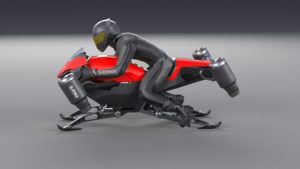 For manned flight we are aiming for before the end of next year.
For manned flight we are aiming for before the end of next year.
What future market do you see for the Speeder?
Initially there will be a military opportunity for us. It’s the only vehicle that can be always used without having to call a helicopter in. The applications include high-speed cargo delivery, exfil / infil and medevac – when you are in a contested environment and access and speed can save lives.
In the civilian context, fire fighting will be a great use of the vehicle. It can scale to carry over a 1,000 lbs (450kg) of fire retardant. Speeders could be carried on trailers by fire departments, deployed and controlled autonomously, delivering fire retardant accurately. The Speeder and the jetpack are hardly affected by wind.
We’re partnering with the world’s largest EMS (emergency medical services) company, which sees the opportunity for moving medics in an urban environment on Speeders. Studies show that you have to land a helicopter within 200ft (60m) of a target, or the medic might as well have traveled by road.
The third phase, probably when we do go electric, is a very high speed, two-seat urban air mobility solution, probably a taxi service.


